Seated leg exercises are ideal for improving circulation, strengthening muscles, and enhancing mobility, especially for those with limited movement or desk jobs. They require minimal equipment and can be adapted to various fitness levels, making them accessible to everyone.
1.1 Benefits of Seated Leg Exercises
Seated leg exercises offer numerous benefits, making them an excellent addition to any fitness or rehabilitation routine. They improve circulation, strengthen muscles, and enhance mobility, particularly for those with limited movement. These exercises are ideal for office workers, as they can be done discreetly at a desk, helping to combat the effects of prolonged sitting. Seniors also benefit, as seated exercises provide a safe way to maintain lower body strength and balance, reducing the risk of falls. Additionally, seated leg exercises are low-impact, making them suitable for individuals recovering from injuries or surgeries. They can also be modified to suit different fitness levels, from beginners to those seeking active recovery. Regular practice improves posture, enhances joint flexibility, and boosts overall lower body strength. Plus, many seated leg exercises require no equipment, making them accessible anywhere. Incorporating these exercises into your routine can lead to better physical function and overall health, regardless of age or fitness level.
1.2 Why Seated Exercises Are Ideal for Office Workers
Seated leg exercises are particularly well-suited for office workers due to their ability to counteract the negative effects of prolonged sitting. Many office workers spend hours each day sitting at a desk, which can lead to muscle atrophy, poor circulation, and stiffness. Seated exercises provide a convenient way to stay active without leaving the workplace. They require minimal space and no special equipment, making them easy to incorporate into a busy workday. These exercises can be done discreetly, allowing employees to maintain productivity while improving their physical health. Regular seated leg exercises can also reduce the risk of developing back pain and other musculoskeletal issues common among office workers. Additionally, they help improve blood flow and oxygen delivery to the muscles, which can enhance energy levels and focus. For individuals with desk jobs, seated exercises offer a practical solution to staying active and healthy without disrupting their workflow.

Essential Seated Leg Exercises
This section introduces the most effective seated leg exercises to improve strength, flexibility, and circulation. Perfect for those with limited mobility or busy schedules, these exercises can be performed anywhere, making them ideal for maintaining leg health.
2.1 Seated Leg Raises
Seated leg raises are a simple yet effective exercise for targeting the lower abdominal muscles and hip flexors. To perform this exercise, sit on a chair with your back straight, knees bent at 90 degrees, and feet flat on the floor. Engage your core, then slowly lift one leg toward your chest while keeping the other foot grounded. Hold for a few seconds before lowering your leg back down. Alternate legs with each repetition.
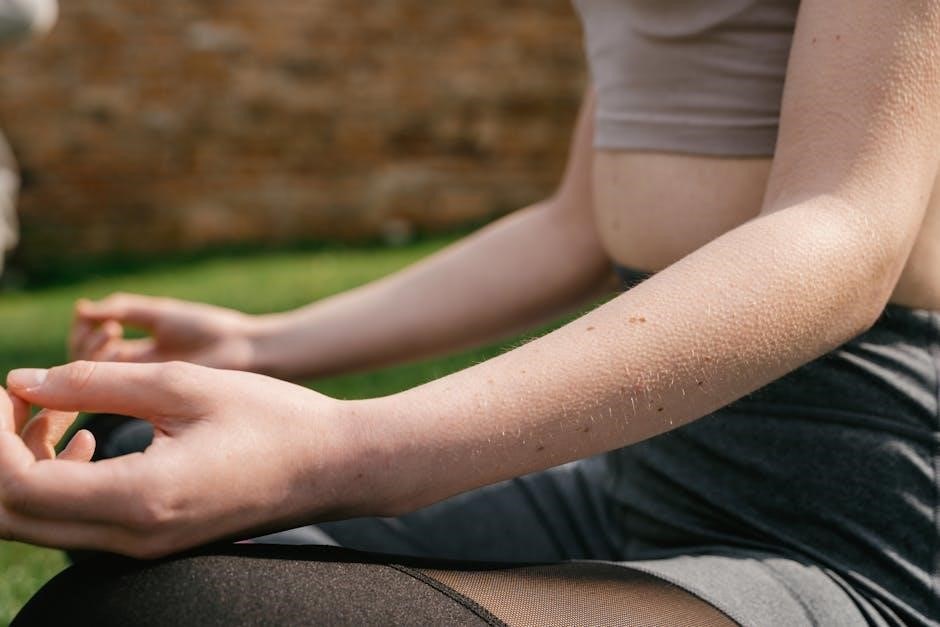
This exercise improves flexibility, strengthens the abdominals, and enhances blood circulation in the legs. For added challenge, you can extend the leg fully before lowering it or incorporate light weights. Proper form is essential to avoid straining the lower back. Start with 10-15 repetitions per leg and gradually increase as your strength improves. Seated leg raises are an excellent option for those who prefer low-impact exercises or have mobility limitations.
- Variations: Add ankle weights for resistance or alternate legs for a dynamic workout.
- Tip: Focus on slow, controlled movements to maximize muscle engagement.
Incorporating seated leg raises into your routine can enhance overall leg strength and core stability, making it a versatile exercise for various fitness goals. For detailed instructions and visuals, refer to the seated leg exercises PDF.
2.2 Seated Leg Extensions
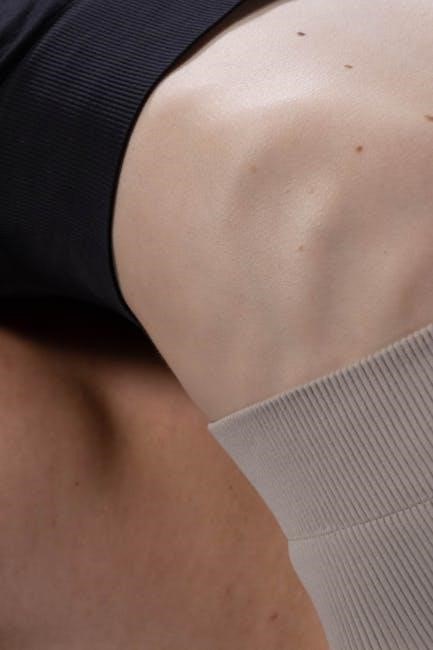
Seated leg extensions are an excellent exercise for strengthening the quadriceps and improving knee mobility. To perform this exercise, sit on a sturdy chair with your back straight, knees bent at 90 degrees, and feet flat on the floor. Slowly extend one leg forward, keeping it straight, while maintaining control. Hold for a few seconds, then lower your leg back to the starting position. Alternate legs with each repetition.
This exercise is ideal for building leg strength without putting excessive strain on the joints. It also enhances circulation and flexibility in the legs. For added intensity, you can incorporate light ankle weights or resistance bands. Proper posture is essential to avoid discomfort or injury. Start with 10-15 repetitions per leg and gradually increase as you build strength.
- Tip: Focus on smooth, controlled movements to maximize the effectiveness of the exercise.
- Variation: Alternate legs quickly for a dynamic workout or hold the extended position for longer durations.
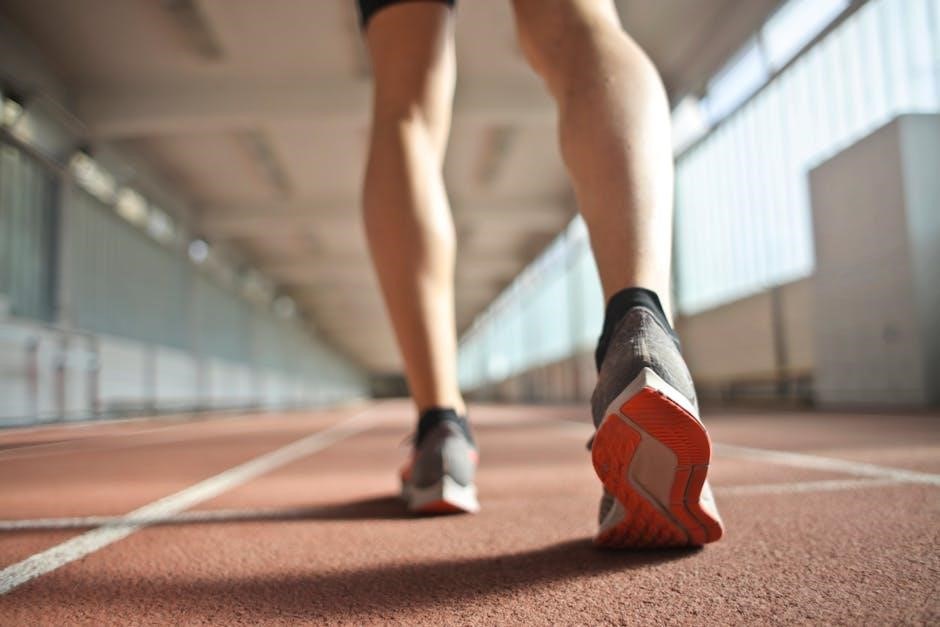
Seated leg extensions are a great addition to any seated leg workout routine, offering both strength and flexibility benefits. For detailed guidance, refer to the seated leg exercises PDF.

2.3 Seated Calf Raises
Seated calf raises are an effective exercise for strengthening the calf muscles (gastrocnemius and soleus) while improving ankle mobility. To perform this exercise, sit on a sturdy chair with your feet flat on the floor, knees bent at 90 degrees. Hold onto the edge of the chair for balance if needed.
Slowly lift your heels off the ground, raising your calves as high as possible. Hold for 2-3 seconds at the top, then lower your heels back down to the starting position. Perform 15-20 repetitions for 2-3 sets. This exercise is low-impact and ideal for strengthening the lower legs without putting excessive strain on the joints.
- Tip: To increase intensity, wear light ankle weights or use resistance bands around your lower legs.
- Variation: Perform the exercise with one leg at a time for targeted muscle engagement.
Seated calf raises are a versatile and easy-to-do exercise, making them suitable for all fitness levels, including seniors and those recovering from injuries. For detailed instructions, refer to the seated leg exercises PDF.
2.4 Seated Figure Four
The seated figure four exercise targets the hips and legs, improving flexibility and strengthening the muscles around the hip joint. To perform this exercise, sit upright in a chair with your feet flat on the floor. Cross one ankle over the opposite knee, forming a “figure four” shape, and gently press your knee outward.
Hold for 20-30 seconds, then release and repeat on the other side. Perform 2-3 repetitions on each leg. This exercise is particularly effective for improving hip mobility and relieving tension in the lower body. It is also a great option for those who spend long hours sitting, as it helps counteract the effects of prolonged sitting.
- Tip: To deepen the stretch, gently press on the knee with your hand while maintaining a straight back.
- Variation: For a more intense stretch, hold the position for 5-10 breaths and focus on relaxing the muscles.
Seated figure four is a low-impact, easy-to-perform exercise that can be incorporated into any seated leg workout routine. For detailed visual guidance, refer to the seated leg exercises PDF.
2.5 Seated Leg Circles
Seated leg circles are an excellent exercise for improving leg flexibility, balance, and muscle engagement. To perform this exercise, sit upright in a chair with your feet flat on the floor or slightly lifted off the ground. Extend one leg out to the side, keeping it straight, and draw small circles in the air with your leg.
Start with small circles and gradually increase their size as you become more comfortable with the movement. After 5-8 repetitions, switch directions and repeat. Perform this exercise on both legs for 2-3 sets each. Seated leg circles are beneficial for enhancing hip mobility, strengthening the lower body, and improving circulation.
- Tip: Focus on controlled, smooth movements to maximize the benefits and avoid strain.
- Benefit: This exercise is ideal for office workers and individuals who need a gentle, low-impact leg workout.
For visual guidance and detailed instructions, refer to the seated leg exercises PDF, which provides step-by-step illustrations and tips for proper form. Incorporate seated leg circles into your routine for a well-rounded leg workout that enhances flexibility and strength.
Variations for Different Needs
This section explores how seated leg exercises can be adapted to suit various needs, ensuring accessibility for everyone. The seated leg exercises PDF offers guidance on modifying exercises based on individual requirements, making them suitable for different fitness levels and goals, promoting overall well-being.
3.1 Seated Leg Exercises for Seniors
Seated leg exercises are an excellent way for seniors to maintain strength, flexibility, and mobility while minimizing the risk of injury. These exercises are low-impact and can be done from the comfort of a chair, making them ideal for individuals with limited mobility or balance concerns.
The seated leg exercises PDF provides tailored routines for seniors, focusing on gentle movements that improve circulation, strengthen muscles, and enhance joint flexibility. Exercises like seated leg raises and seated leg extensions are particularly beneficial, as they target the quadriceps, hamstrings, and calves without putting excessive strain on the body.
Seniors can also benefit from seated calf raises, which help prevent swelling in the legs and improve venous circulation. Additionally, seated figure-four stretches can gently improve hip mobility and reduce stiffness. These exercises are easy to follow and can be modified to suit individual fitness levels.
By incorporating seated leg exercises into their daily routine, seniors can maintain independence, improve overall health, and reduce the risk of falls. Always consult a healthcare provider before starting any new exercise program, especially if there are underlying medical conditions.
3.2 Seated Leg Exercises for Beginners
Seated leg exercises are a fantastic starting point for beginners, as they are easy to perform, require minimal equipment, and can be done in the comfort of your own home. The seated leg exercises PDF offers simple, step-by-step routines designed to help new exercisers build strength, improve flexibility, and enhance overall leg health.
Beginners can start with basic movements like seated leg raises, which target the abdominal and thigh muscles. Seated leg extensions are another great option, focusing on strengthening the quadriceps without putting strain on the knees. These exercises are low-impact and can be modified to suit individual fitness levels.
The PDF also includes tips for proper form and breathing techniques to ensure safety and effectiveness. For those just starting out, it’s important to focus on slow, controlled movements and gradually increase intensity as strength and confidence improve. Incorporating seated leg exercises into a daily routine can help beginners establish a consistent workout habit and set the foundation for more advanced exercises in the future.
Consistency is key, and even short sessions can yield noticeable improvements in leg strength and overall well-being.
3.3 Seated Leg Exercises for Active Recovery
Seated leg exercises are an excellent choice for active recovery, helping to improve circulation, reduce muscle soreness, and maintain flexibility without overexertion. The seated leg exercises PDF offers a variety of gentle, low-impact movements that are perfect for recovery days or post-workout routines.
Exercises like seated leg circles and seated calf raises are ideal for promoting blood flow and relaxing tight muscles. These movements are easy on the joints and can be performed with minimal effort, making them suitable for days when you need to rest but still want to stay active.
Active recovery is crucial for muscle repair and overall fitness progress. Seated leg exercises allow you to engage your lower body without the strain of high-intensity workouts. They also help prevent stiffness and improve range of motion, ensuring you’re ready for your next challenging session.
Incorporating seated leg exercises into your recovery routine can enhance your overall fitness journey. They are convenient, effective, and require no special equipment, making them a great addition to any active recovery plan.
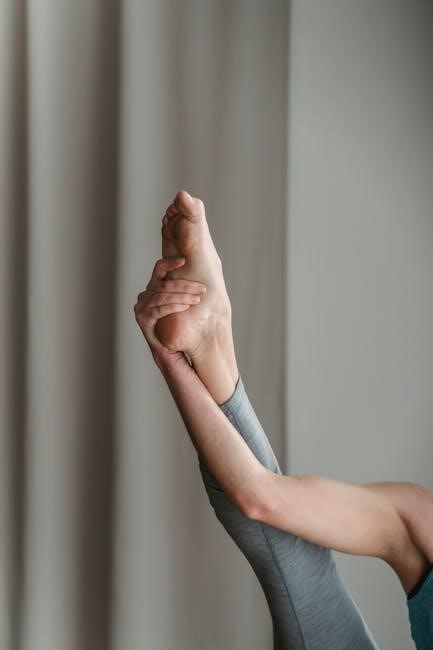
How to Create a Seated Leg Exercise Routine
Creating a seated leg exercise routine involves selecting exercises that target different muscle groups, setting realistic goals, and incorporating proper form. The seated leg exercises PDF provides a clear guide to designing a balanced and effective workout plan.
- Start with a warm-up to prepare your muscles.
- Choose 3-4 exercises per session for variety.
- Gradually increase intensity as you progress.
- Finish with stretching to improve flexibility.
Consult the PDF for detailed exercise variations and safety tips to ensure a successful routine.
4.1 Structuring Your Workout
Structuring your seated leg workout effectively is crucial for maximizing results and preventing fatigue. Begin by setting clear goals, whether it’s improving strength, enhancing flexibility, or boosting circulation. Start with a 5-10 minute warm-up, such as gentle leg swings or ankle rotations, to prepare your muscles.
- Exercise Selection: Choose 3-5 exercises that target different muscle groups, such as quadriceps, hamstrings, and calves.
- Repetitions and Sets: Aim for 12-15 repetitions per set, completing 2-3 sets for each exercise. Adjust based on your fitness level.
- Rest Periods: Take 30-60 seconds of rest between sets to avoid muscle strain.
- Progression: Gradually increase repetitions, sets, or intensity as you build strength.
Include a cool-down session with stretching to improve flexibility and reduce muscle soreness. Refer to the seated leg exercises PDF for sample routines tailored to different fitness levels and goals. Ensure your workout aligns with your schedule and physical capabilities for consistency and safety.
4.2 Tips for Progressing Your Routine

Progressing your seated leg exercise routine is essential to continue challenging your muscles and achieving results. Start by increasing the number of repetitions or sets as your strength improves. For example, if you initially perform 12-15 reps, aim for 18-20 reps in subsequent sessions.
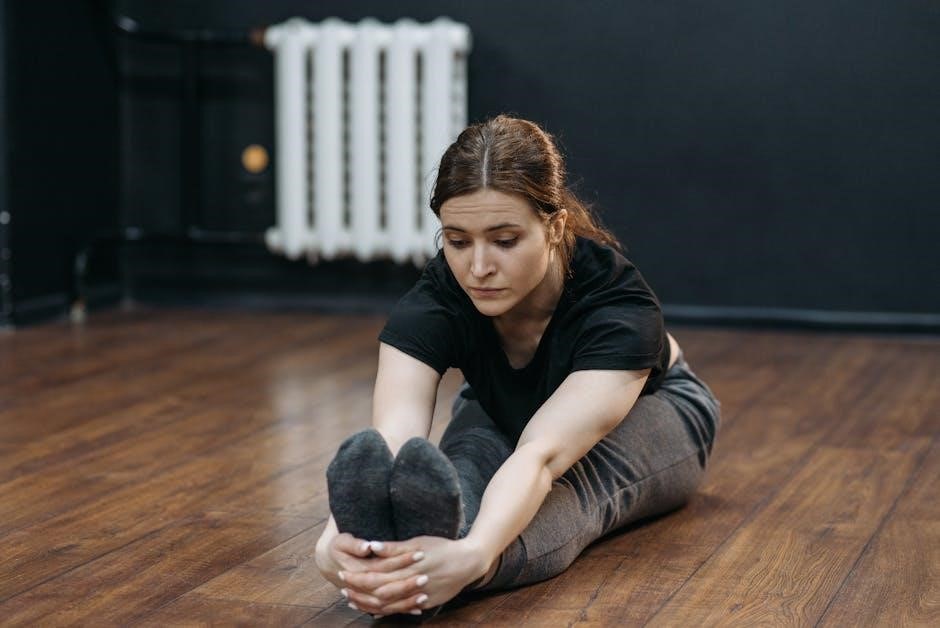
- Add Resistance: Incorporate light weights, resistance bands, or ankle weights to enhance the intensity of exercises like seated leg raises or extensions.
- Increase Frequency: Gradually add more workout days or extend the duration of each session as your endurance builds.
- Introduce Variations: Modify exercises to target different muscle groups. For instance, switch from basic seated leg raises to alternating leg lifts for varied engagement.
- Track Progress: Use a workout log to monitor improvements and stay motivated. Celebrate milestones to maintain consistency.
- Focus on Form: Prioritize proper technique to avoid injury and maximize muscle engagement.
Refer to the seated leg exercises PDF for detailed progression plans and advanced variations tailored to your fitness journey. Always consult a professional before making significant changes to your routine.
Safety Tips and Precautions
Ensure safe seated leg exercises by maintaining proper posture and using controlled movements to avoid injury. Start with gentle exercises and gradually increase intensity. Stay hydrated, listen to your body, and consult a professional if discomfort arises. Follow the seated leg exercises PDF guidelines for safe practices.
5.1 Breathing Techniques During Exercises
Proper breathing is essential when performing seated leg exercises to ensure safety and effectiveness. Always inhale before starting a movement and exhale during the effort phase to maintain core stability. Avoid holding your breath, as this can lead to dizziness or increased blood pressure. Practice deep abdominal breathing to enhance oxygen flow and muscle relaxation. For example, inhale deeply as you prepare for the movement, then exhale slowly as you lift or extend your legs. This technique helps maintain focus and prevents fatigue. Consistent breathing also improves posture and reduces the risk of strain. If you feel lightheaded, stop the exercise and breathe naturally until you recover. Incorporate these techniques into your seated leg exercises PDF routine for a safer and more efficient workout.
5.2 Avoiding Injury While Exercising
Avoiding injury during seated leg exercises requires attention to proper form and technique. Always warm up before starting your routine to prepare your muscles for movement. Use a sturdy, ergonomic chair or exercise bench to ensure stability and support. Avoid lifting weights or resistance that are too heavy, as this can strain your muscles or joints. Move slowly and deliberately, avoiding jerky or bouncy movements that may cause sudden stress. If you experience pain or discomfort, stop the exercise immediately and rest.
- Keep your posture straight to prevent unnecessary strain on your back and neck.
- Stay hydrated to maintain muscle function and flexibility.
- Listen to your body and take regular breaks to avoid fatigue.
For individuals with pre-existing conditions, consult a healthcare professional or physical therapist to tailor exercises to your needs. Incorporate these safety tips into your seated leg exercises PDF to promote a safe and effective workout routine.
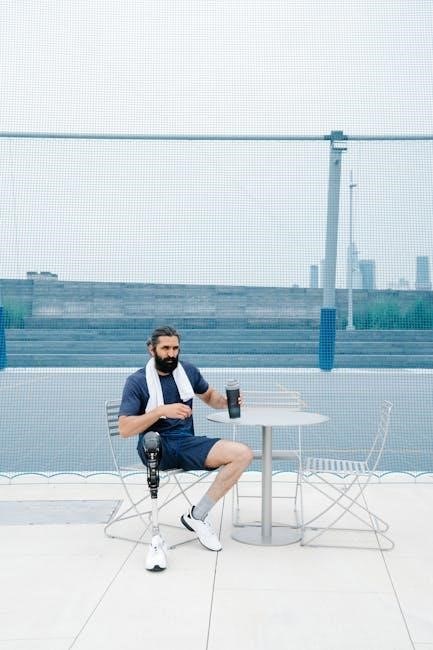
Sample Seated Leg Exercises PDF Template
A sample seated leg exercises PDF template provides a structured guide, including exercise instructions, visual demonstrations, and customizable workout plans. It helps users follow routines effectively and track their progress for better fitness outcomes.
6.1 Exercise Instructions
Clear and detailed exercise instructions are essential for maximizing the effectiveness of seated leg exercises. Each exercise in the PDF template is accompanied by step-by-step guidance, ensuring proper form and technique. For example, seated leg raises involve lifting one leg at a time while keeping the knee straight, holding for a few seconds, and then lowering it slowly. Similarly, seated leg extensions require extending the legs outward while engaging the quadriceps, holding the position briefly before returning to the starting point.
Visual cues and anatomical focus points are included to help users maintain correct posture and target the right muscle groups. Modifications are also provided to accommodate different fitness levels, such as reducing the range of motion for beginners or adding resistance for advanced individuals. The instructions emphasize the importance of controlled movements and breathing to enhance safety and efficiency. By following these guidelines, users can perform each exercise confidently and effectively, achieving their fitness goals without risking injury.
6.2 Visual Demonstrations
Visual demonstrations are a crucial component of the seated leg exercises PDF, providing users with a clear understanding of proper form and technique. High-quality images or illustrations are included for each exercise, showcasing the starting position, movement, and ending position. These visuals help users identify correct posture, alignment, and muscle engagement, reducing the risk of improper form and injury.
Each exercise is depicted from multiple angles, allowing users to see the movement in detail. For example, seated leg circles are illustrated with arrows indicating the direction of the leg movement, while seated calf raises show the heel lift and lower phases. Additionally, modifying exercises for different fitness levels is visually represented, such as using resistance bands or adjusting the range of motion.
These visual aids complement the written instructions, making the exercises more accessible and easier to follow. They cater to visual learners and ensure that users can perform each exercise confidently and safely, maximizing the effectiveness of their seated leg workout routine.
7.1 Final Tips for Effective Seated Leg Workouts
To maximize the benefits of seated leg exercises, prioritize proper form to avoid injury and ensure effectiveness. Start with manageable sets and gradually increase intensity as you build strength and endurance. Incorporate variations to target different muscle groups and keep your workouts engaging. Consistency is key—aim to perform these exercises 3-4 times a week for noticeable results. Additionally, focus on breathing techniques to maintain oxygen flow and prevent strain. For office workers, try to move every hour to avoid prolonged sitting, even if it’s just a few leg raises or extensions. Seniors can benefit from slower, controlled movements to enhance stability. Finally, pair your seated leg exercises with a balanced diet and adequate hydration to support muscle health. By following these tips, you can create a sustainable and effective seated leg workout routine that fits your lifestyle and goals.